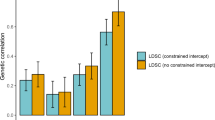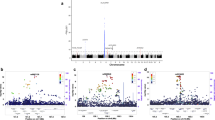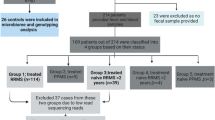Abstract
Genome-wide studies highlighted the effect in Crohn's disease (CD) and ulcerative colitis (UC) susceptibility of single nucleotide polymorphisms (SNPs) in 3p21, where BSN (bassoon), MST1 (macrophage stimulating-1) and MST1R (MST1 Receptor) genes map. MST1R expression was significantly downregulated in multiple sclerosis (MS) compared with control brains, resembling findings in the MS mouse model. We pursued to replicate the effect of this locus on inflammatory bowel diseases and to evaluate its contribution to MS risk. Polymorphisms rs9858542, rs2131109 and rs1128535 were analysed by TaqMan assays in Spanish patients (370 CD, 405 UC and 415 MS) and 800 ethnically matched controls. Allele frequencies of these SNPs were significantly different in CD patients compared with controls [rs9858542: P=0.001, Odds ratio (OR)=1.35; rs2131109: P=0.0005, OR=1.37; rs1128535: P=0.007, OR=0.78] and, specifically, in the ileal phenotype [rs9858542: P=0.0004, OR=1.47; rs2131109: P=0.00009, OR=1.52; rs1128535: P=0.02, OR=0.69]. No differences were detected between UC or MS patients and control individuals. The effect of this locus on CD predisposition was replicated, but no influence on UC or MS predisposition could be detected. This susceptibility locus seems to affect mainly to the ileal CD subphenotype, although this point awaits further corroboration in independent cohorts.
This is a preview of subscription content, access via your institution
Access options
Subscribe to this journal
Receive 6 digital issues and online access to articles
$119.00 per year
only $19.83 per issue
Buy this article
- Purchase on Springer Link
- Instant access to full article PDF
Prices may be subject to local taxes which are calculated during checkout
Similar content being viewed by others
References
Wellcome Trust Case Control Consortium. Genome-wide association study of 14 000 cases of seven common diseases and 3 000 shared controls. Nature 2007; 447: 661–678.
Parkes M, Barrett JC, Prescott NJ, Tremelling M, Anderson CA, Fisher SA et al. Sequence variants in the autophagy gene IRGM and multiple other replicating loci contribute to Crohn's disease susceptibility. Nat Genet 2007; 39: 830–832.
Fisher SA, Tremelling M, Anderson CA, Gwilliam R, Bumpstead S, Prescott NJ et al. Genetic determinants of ulcerative colitis include the ECM1 locus and five loci implicated in Crohn's disease. Nat Genet 2008; 40: 710–712.
Franke A, Balschun T, Karlsen TH, Hedderich J, May S, Lu T et al. Replication of signals from recent studies of Crohn's disease identifies previously unknown disease loci for ulcerative colitis. Nat Genet 2008; 40: 713–715.
Goyette P, Lefebvre C, Ng A, Brant SR, Cho JH, Duerr RH et al. Gene-centric association mapping of chromosome 3p implicates MST1 in IBD pathogenesis. Mucosal Immunol 2008; 1: 131–138.
Silverberg MS, Cho JH, Rioux JD, McGovern DP, Wu J, Annese V et al. Ulcerative colitis-risk loci on chromosomes 1p36 and 12q15 found by genome-wide association study. Nat Genet 2009; 41: 216–220.
Leonard EJ, Skeel AH . Isolation of macrophage stimulating protein (MSP) from human serum. Exp Cell Res 1978; 114: 117–126.
Morrison AC, Wilson CB, Ray M, Correll PH . Macrophage-stimulating protein, the ligand for the stem cell-derived tyrosine kinase/RON receptor tyrosine kinase, inhibits IL-12 production by primary peritoneal macrophages stimulated with IFN-gamma and lipopolysaccharide. J Immunol 2004; 172: 1825–1832.
Stella MC, Vercelli A, Repici M, Follenzi A, Comoglio PM . Macrophage stimulating protein is a novel neurotrophic factor. Mol Biol Cell 2001; 12: 1341–1352.
Tsutsui S, Noorbakhsh F, Sullivan A, Henderson AJ, Warren K, Toney-Earley K et al. RON-regulated innate immunity is protective in an animal model of multiple sclerosis. Ann Neurol 2005; 57: 883–895.
Bottini N, Vang T, Cucca F, Mustelin T . Role of PTPN22 in type 1 diabetes and other autoimmune diseases. Semin Immunol 2006; 18: 207–213.
Martinez A, Varade J, Marquez A, Cenit MC, Espino L, Perdigones N et al. Association of the STAT4 gene with increased susceptibility for some immune-mediated diseases. Arthritis Rheum 2008; 58: 2598–2602.
Altrock WD, tom Dieck S, Sokolov M, Meyer AC, Sigler A, Brakebusch C et al. Functional inactivation of a fraction of excitatory synapses in mice deficient for the active zone protein bassoon. Neuron 2003; 37: 787–800.
Angenstein F, Hilfert L, Zuschratter W, Altrock WD, Niessen HG, Gundelfinger ED . Morphological and metabolic changes in the cortex of mice lacking the functional presynaptic active zone protein bassoon: a combined 1H-NMR spectroscopy and histochemical study. Cereb Cortex 2008; 18: 890–897.
Baranzini SE, Wang J, Gibson RA, Galwey N, Naegelin Y, Barkhof F et al. Genome-wide association analysis of susceptibility and clinical phenotype in multiple sclerosis. Hum Mol Genet 2009; 18: 767–778.
Hafler DA, Compston A, Sawcer S, Lander ES, Daly MJ, De Jager PL et al. Risk alleles for multiple sclerosis identified by a genomewide study. N Engl J Med 2007; 357: 851–862.
Beckly JB, Hancock L, Geremia A, Cummings JR, Morris A, Cooney R et al. Two-stage candidate gene study of chromosome 3p demonstrates an association between nonsynonymous variants in the MST1R gene and Crohn's disease. Inflamm Bowel Dis 2008; 14: 500–507.
Lee SY, Lee SY, Choi Y . TRAF-interacting protein (TRIP): a novel component of the tumor necrosis factor receptor (TNFR)- and CD30-TRAF signaling complexes that inhibits TRAF2-mediated NF-kappaB activation. J Exp Med 1997; 185: 1275–1285.
Lennard-Jones JE . Classification of inflammatory bowel disease. Scand J Gastroenterol Suppl 1989; 170: 2–6; discussion 16–19.
Poser CM, Paty DW, Scheinberg L, McDonald WI, Davis FA, Ebers GC et al. New diagnostic criteria for multiple sclerosis: guidelines for research protocols. Ann Neurol 1983; 13: 227–231.
Fernandez L, Mendoza JL, Martinez A, Urcelay E, Fernandez-Arquero M, Garcia-Paredes J et al. IBD1 and IBD3 determine location of Crohn's disease in the Spanish population. Inflamm Bowel Dis 2004; 10: 715–722.
Zeggini E, Weedon MN, Lindgren CM, Frayling TM, Elliott KS, Lango H et al. Replication of genome-wide association signals in UK samples reveals risk loci for type 2 diabetes. Science 2007; 316: 1336–1341.
Saxena R, Voight BF, Lyssenko V, Burtt NP, de Bakker PI, Chen H et al. Genome-wide association analysis identifies loci for type 2 diabetes and triglyceride levels. Science 2007; 316: 1331–1336.
Scott LJ, Mohlke KL, Bonnycastle LL, Willer CJ, Li Y, Duren WL et al. A genome-wide association study of type 2 diabetes in Finns detects multiple susceptibility variants. Science 2007; 316: 1341–1345.
Sladek R, Rocheleau G, Rung J, Dina C, Shen L, Serre D et al. A genome-wide association study identifies novel risk loci for type 2 diabetes. Nature 2007; 445: 881–885.
Acknowledgements
We thank Carmen Martínez and M Angel García for their skilful technical assistance. Elena Urcelay works for the ‘Fundación para la Investigación Biomédica-Hospital Clínico San Carlos’. This work was supported by grants from ‘Fundación Mutua Madrileña’, ‘Fundación Ramón Areces’, ‘Fundación Alfonso Martín Escudero’ and FIS PI07/0353.
Author information
Authors and Affiliations
Corresponding author
Rights and permissions
About this article
Cite this article
Márquez, A., Cénit, M., Núñez, C. et al. Effect of BSN-MST1 locus on inflammatory bowel disease and multiple sclerosis susceptibility. Genes Immun 10, 631–635 (2009). https://doi.org/10.1038/gene.2009.56
Received:
Revised:
Accepted:
Published:
Issue Date:
DOI: https://doi.org/10.1038/gene.2009.56
Keywords
This article is cited by
-
Quantitative Profiling of Single Formalin Fixed Tumour Sections: proteomics for translational research
Scientific Reports (2016)
-
Genome-wide searching of rare genetic variants in WTCCC data
Human Genetics (2010)



